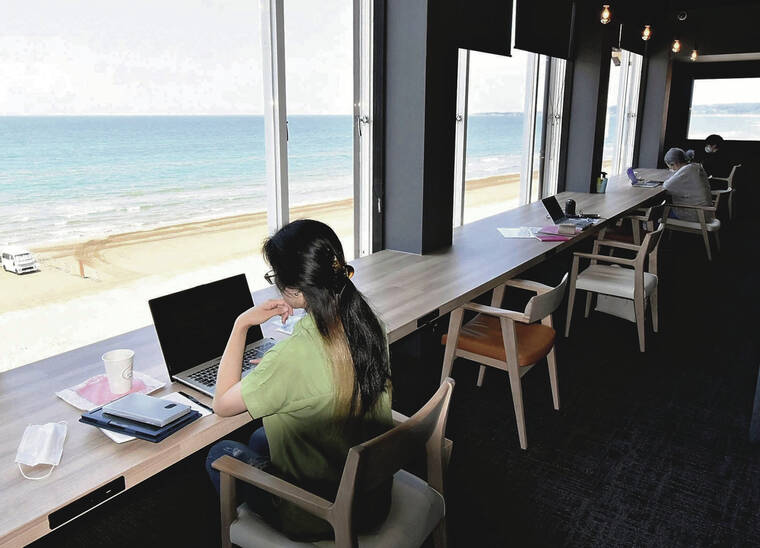Population growth slows in crowded Tokyo

YOMIURI SHIMBUN / AUG. 21
The Coworking Base Chirihama in Hakui is the kind of facility that encourages people to move out of Tokyo and work remotely. It boasts Wi-Fi and private booths for online meetings, not to mention a picture-perfect view of the Sea of Japan. Japan’s government is encouraging companies and workers to leave Tokyo for less-populated regional areas.
TOKYO >> Growth in the number of Japanese nationals living in Tokyo has slowed as fewer people moved to the capital following the outbreak of COVID-19.
As of Jan. 1, Tokyo’s population of Japanese nationals had increased by 39,493, according to a survey, and population was up 0.3% from a year earlier. But on Jan. 1, 2020, the number of Japanese residents grew by 68,547, an increase of 0.52% over the same time period.
And even as the number of people moving into Tokyo decreased, those moving out of the prefecture increased by about 13,100.
The government had already started addressing the overconcentration of people in Tokyo, with funding support for telecommuting and other incentives. But some experts believe the curbed growth is temporary.
One senior government official said the pandemic likely motivated people to leave the city. As the virus spread last year, the risk of infection was particularly high in Tokyo, where the population is densely concentrated.
The first state of emergency, declared in April 2020, triggered a growth in telecommuting, which allowed people to relocate outside the city.
Don't miss out on what's happening!
Stay in touch with breaking news, as it happens, conveniently in your email inbox. It's FREE!
Among the 47 prefectures in Japan — Tokyo is the largest, with about 13.3 million Japanese citizens — 42 prefectures saw their populations drop over the past year; however, the rate of decline shrank.
In Chiba and Saitama prefectures, populations grew instead of declined, while the rate of population growth rose in Okinawa and Kanagawa prefectures.
To address the overconcentrated population in Tokyo, the government introduced tax incentives for companies relocating to regional areas and subsidies for people who move there. Yet the results have not been significant.
Still, the government continues to encourage people to move from the city. It has earmarked a “regional development telecommuting subsidy” to support the development of satellite offices by local governments.
In Hakui, Ishikawa prefecture, which faces the Sea of Japan, the Coworking Base Chirihama opened in September. The facility is equipped with Wi-Fi, a multifunctional printer and private booths for online meetings — as well as picturesque views of the ocean.
What’s unclear is whether more people will migrate to regional areas. While the rate of population growth in Tokyo has slowed, the number of Tokyo residents has yet to decline.
“We’ve discovered that even the outbreak of a virus cannot easily change the trend,” said a senior Cabinet Secretary official.
An issue that goes hand-in-hand is the limited growth of telecommuting.
In a survey conducted in July by the Japan Productivity Center, 49.7% of respondents said their work efficiency had “decreased” or “slightly decreased” while working from home.
“Telecommuting will settle down once the coronavirus is resolved,” said Akira Kakioka, a senior researcher at the center. “I don’t think it will become more widespread in the future.”




